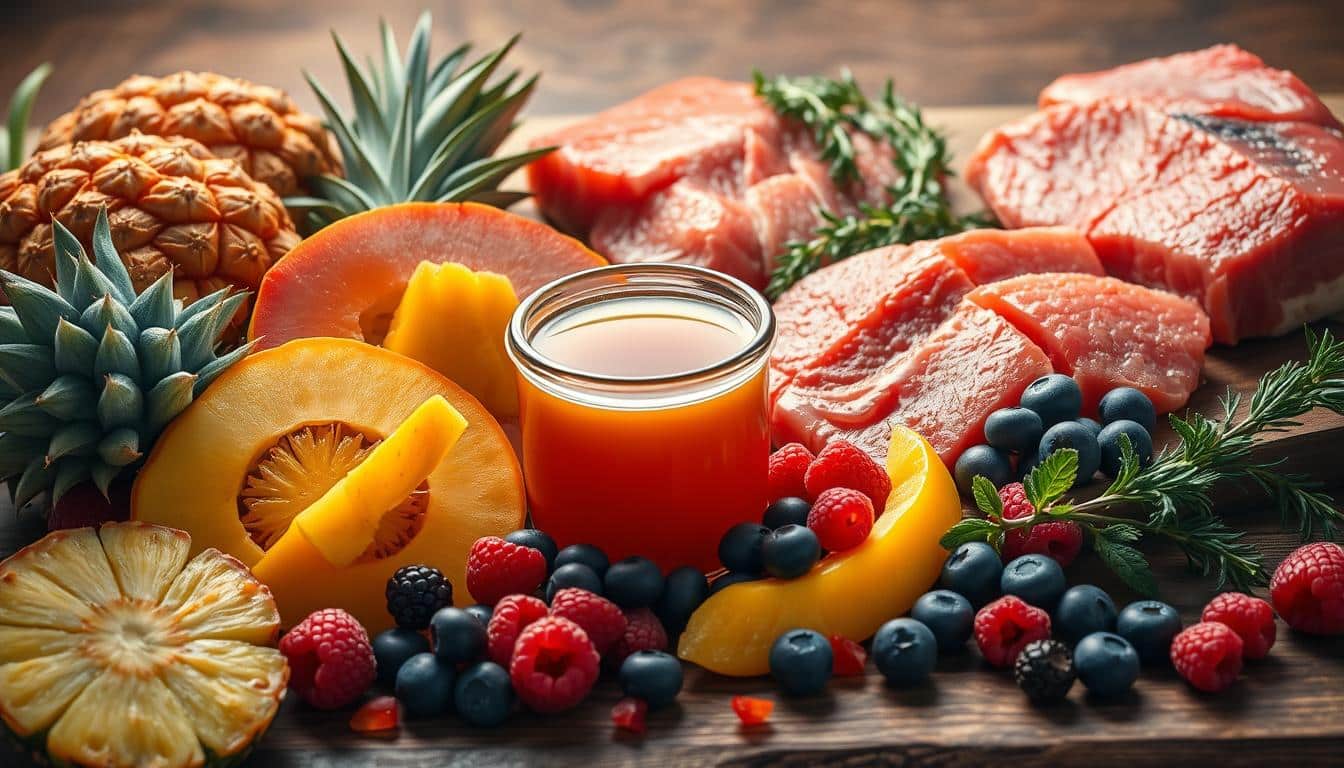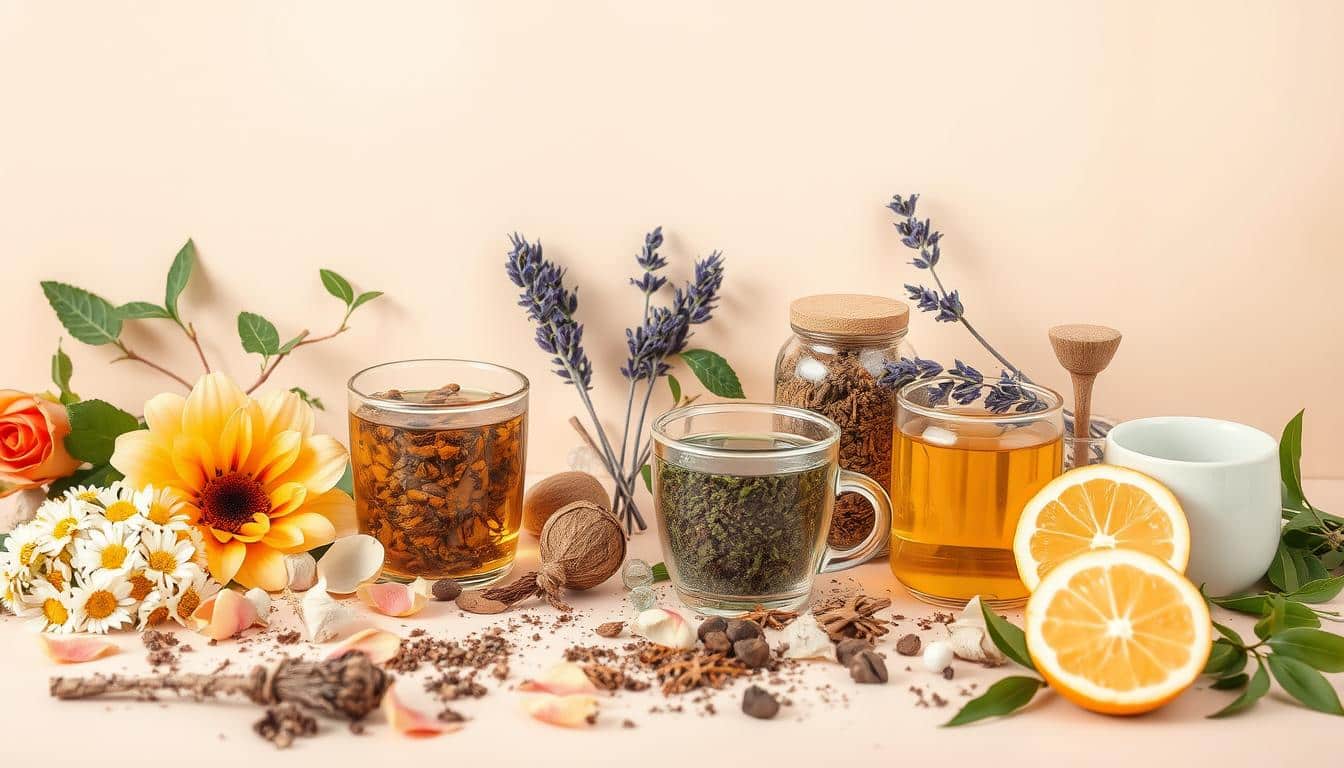Anúncios
Headaches can be debilitating, affecting daily life and productivity. While medication is often the go-to solution, incorporating specific foods into your diet can provide headache relief. Nutrition plays a crucial role in managing headache symptoms, and certain natural remedies have been found to be particularly effective.
Understanding the link between diet and headaches is essential for finding long-term relief. By making informed choices about what we eat, we can potentially reduce the frequency and severity of headaches. This article will explore the nutritional approaches to headache relief, highlighting the foods that can help alleviate symptoms.
Anúncios

Natural Foods to Relieve Headaches
Key Takeaways
- Certain foods can trigger or relieve headache symptoms.
- A balanced diet rich in essential nutrients can help manage headaches.
- Staying hydrated is crucial for headache prevention.
- Some natural remedies have been shown to provide headache relief.
- Nutritional deficiencies can contribute to headache frequency.
Understanding Different Types of Headaches
Headaches can be debilitating, and understanding their types is crucial for effective relief. Headaches are not just a simple pain; they can be a sign of an underlying condition that needs attention. The various types of headaches include tension headaches, migraines, cluster headaches, and sinus headaches, each with its unique set of symptoms and causes.
Tension Headaches: Symptoms and Causes
Tension headaches are the most common type, characterized by a dull, aching pain on both sides of the head. They are often caused by muscle tension in the neck and scalp, usually triggered by stress, poor posture, or fatigue. Relaxation techniques and improving posture can help alleviate tension headache symptoms.
Anúncios
Migraines: Beyond Ordinary Pain
Migraines are more than just severe headaches; they are a neurological condition that can cause intense pain, usually on one side of the head, along with nausea, vomiting, and sensitivity to light and sound. Understanding migraine triggers is crucial for managing and preventing these episodes.
Cluster Headaches and Their Patterns
Cluster headaches occur in cyclical patterns or clusters, characterized by severe, one-sided pain often accompanied by tearing and redness of the eye. These headaches can be extremely painful and may require specific medical attention to manage their occurrence and severity.
Sinus Headaches vs. Sinus Infections
Sinus headaches are often confused with sinus infections, but they have distinct causes. Sinus headaches result from sinus inflammation due to allergies or infection, causing pain in the face and forehead. Distinguishing between sinus headaches and infections is vital for appropriate treatment.
The Connection Between Food and Headaches
The connection between food and headaches is multifaceted, involving aspects such as nutrition, inflammation, and blood sugar levels. Understanding this complex relationship can help individuals make informed dietary choices to alleviate headache symptoms.
How Nutrition Affects Brain Function
Nutrition plays a critical role in brain function, influencing the frequency and severity of headaches. A diet rich in essential nutrients supports optimal brain health, while nutritional deficiencies can lead to headache pain. For instance, magnesium and riboflavin (Vitamin B2) are known to have a positive impact on headache prevention.
- Magnesium helps regulate blood vessel constriction and dilation.
- Riboflavin is involved in energy production within cells.
The Role of Inflammation in Headache Pain
Inflammation is a significant factor in headache pain, particularly for migraines. Certain foods can trigger or reduce inflammation. For example, omega-3 fatty acids found in salmon and flaxseeds have anti-inflammatory properties that may help alleviate headache symptoms.
“Dietary interventions that reduce inflammation can be an effective strategy for managing headache pain.”
Blood Sugar Fluctuations and Headache Triggers
Blood sugar fluctuations can trigger headaches due to the impact on blood vessel health and neurotransmitter function. Consuming foods that help maintain stable blood sugar levels, such as whole grains and vegetables, can be beneficial. Avoiding sugary snacks and caffeine can also help prevent blood sugar spikes.
- Eating regular, balanced meals.
- Including protein and healthy fats in meals to stabilize blood sugar.
By understanding the connection between food and headaches, individuals can make targeted dietary changes to reduce headache frequency and severity.
Natural Foods that Relieve Headaches
The right foods can play a crucial role in reducing the frequency and severity of headaches. By incorporating nutrient-rich foods into your diet, you can help alleviate headache symptoms and improve overall health. Certain foods are particularly beneficial due to their high content of magnesium, potassium, riboflavin, and omega-3 fatty acids.
Magnesium-Rich Foods: Spinach, Avocados, and Dark Chocolate
Magnesium deficiency is often linked to headache pain. Foods rich in magnesium, such as spinach, avocados, and dark chocolate, can help relax blood vessels and reduce headache frequency.
Potassium Powerhouses: Bananas, Sweet Potatoes, and Coconut Water
Potassium helps regulate fluid balance in the body and can alleviate headache symptoms. Include bananas, sweet potatoes, and coconut water in your diet to boost potassium intake.
Riboflavin (Vitamin B2) Sources: Eggs, Mushrooms, and Almonds
Riboflavin has been shown to reduce migraine frequency. Consume foods rich in riboflavin, such as eggs, mushrooms, and almonds, to potentially decrease headache occurrences.
Omega-3 Fatty Acids: Salmon, Walnuts, and Flaxseeds
Omega-3 fatty acids possess anti-inflammatory properties that can help alleviate headache pain. Include salmon, walnuts, and flaxseeds in your meals to benefit from their omega-3 content.
| Food | Nutrient | Benefit |
|---|---|---|
| Spinach | Magnesium | Relaxes blood vessels |
| Bananas | Potassium | Regulates fluid balance |
| Eggs | Riboflavin (Vitamin B2) | Reduces migraine frequency |
| Salmon | Omega-3 Fatty Acids | Anti-inflammatory properties |
Hydration Heroes: Drinks That Prevent Headaches
Proper hydration, achieved through the right drinks, is essential for minimizing headache occurrences. Dehydration is a common trigger for headaches, and maintaining adequate fluid balance can significantly reduce their frequency.
Water and Electrolyte Balance: How Much You Need Daily
Drinking enough water is crucial, but it’s equally important to maintain electrolyte balance. Electrolytes, such as sodium, potassium, and calcium, help regulate various bodily functions, including nerve and muscle function. The general recommendation is to drink at least eight glasses of water a day, but individual needs may vary based on activity level, climate, and overall health.
| Drink | Electrolytes | Benefits |
|---|---|---|
| Water | None | Basic hydration |
| Coconut Water | Potassium, Sodium | Replenishes electrolytes |
| Herbal Teas | Varies | Relaxation, hydration |
Herbal Teas: Peppermint, Chamomile, and Ginger
Herbal teas are not only hydrating but also offer additional benefits. Peppermint tea can help ease tension and improve focus, while chamomile tea promotes relaxation and reduces stress. Ginger tea has anti-inflammatory properties that can help alleviate pain.
Natural Fruit Waters and Infusions
Infusing water with fruits, cucumbers, or mint can make hydration more enjoyable. These infusions can add flavor without adding sugars or calories, making them a great alternative to plain water. Popular infusions include lemon and ginger, strawberry and mint, or cucumber and lime.
By incorporating these hydration heroes into your daily routine, you can take a significant step towards preventing headaches and improving overall well-being.
Fruits That Fight Headache Pain
Fresh fruits are not just a healthy snack; they can also help combat headache pain. Incorporating the right fruits into your diet can provide relief from headache symptoms. Let’s explore some of the most beneficial fruits for headache sufferers.
Anti-inflammatory Berries
Berries are packed with antioxidants and have potent anti-inflammatory properties, making them an excellent choice for reducing headache pain. Blueberries, strawberries, and raspberries are among the top berries that can help alleviate headache symptoms.
Watermelon and Cucumber for Hydration
Staying hydrated is crucial for headache prevention, and watermelon and cucumber are two hydrating fruits that can help. Watermelon is rich in water content, while cucumber has anti-inflammatory properties that can soothe headache pain.
Cherries and Natural Pain Relief
Cherries contain compounds that have natural pain-relieving properties. Consuming cherries or cherry juice can help reduce headache frequency and severity. Tart cherries are particularly effective due to their high concentration of anthocyanins.
Vitamin C-Rich Fruits
Fruits rich in vitamin C, such as kiwi, pineapple, and oranges, can also help combat headache pain. Vitamin C is known for its antioxidant properties, which can reduce inflammation and alleviate headache symptoms.
- Berries: Blueberries, strawberries, raspberries
- Hydrating Fruits: Watermelon, cucumber
- Pain-Relieving Fruits: Cherries
- Vitamin C-Rich Fruits: Kiwi, pineapple, oranges
Vegetables and Herbs That Ease Headache Symptoms
The natural world provides a variety of vegetables and herbs that can help mitigate headache symptoms. These foods are not only nutritious but also offer specific benefits that can alleviate headache pain.
Leafy Greens: Spinach, Kale, and Swiss Chard
Leafy greens are rich in magnesium, a mineral that is often deficient in individuals who experience frequent headaches. Spinach, kale, and Swiss chard are excellent sources of magnesium. Incorporating these into your diet can help relax blood vessels and reduce headache frequency.
Ginger: Nature’s Anti-inflammatory Powerhouse
Ginger has been used for centuries for its anti-inflammatory properties. It can help reduce inflammation that may contribute to headache pain. Consuming ginger tea or adding fresh ginger to meals can be an effective way to utilize its benefits.
Feverfew, Butterbur, and Other Medicinal Herbs
Certain herbs have been traditionally used to treat headaches. Feverfew and butterbur are two such herbs that have shown promise in reducing headache frequency and severity. They can be consumed as supplements or teas.
Garlic and Onions: Sulfur Compounds for Circulation
Garlic and onions contain sulfur compounds that can help improve blood circulation. Enhanced circulation can aid in reducing headache pain by ensuring that the brain receives adequate oxygen and nutrients.
| Food | Benefit |
|---|---|
| Leafy Greens (Spinach, Kale, Swiss Chard) | Rich in Magnesium |
| Ginger | Anti-inflammatory Properties |
| Feverfew, Butterbur | Reduce Headache Frequency and Severity |
| Garlic, Onions | Improve Blood Circulation |
Nuts, Seeds, and Grains for Headache Prevention
Exploring the nutritional benefits of nuts, seeds, and whole grains reveals their potential in preventing headaches. These foods are rich in essential nutrients that can help alleviate headache symptoms.
Almonds and Cashews: Magnesium Treasures
Nuts like almonds and cashews are magnesium-rich, making them excellent snacks for headache prevention. Magnesium deficiency is often linked to headache frequency, so incorporating these nuts into your diet can be beneficial.
Flaxseeds, Chia Seeds, and Hemp Hearts
Seeds such as flaxseeds, chia seeds, and hemp hearts are not only rich in omega-3 fatty acids but also provide a good amount of magnesium and fiber. These nutrients work together to reduce inflammation and stabilize blood sugar levels, both of which are crucial for headache prevention.
Whole Grains for Stable Blood Sugar Levels
Whole grains, including brown rice, quinoa, and whole-wheat bread, are rich in complex carbohydrates, fiber, and various minerals. They help maintain stable blood sugar levels, reducing the risk of headache triggers associated with blood sugar fluctuations.
Incorporating these foods into your diet can be simple: start your day with oatmeal or whole-grain toast, snack on almonds or cashews, and add chia seeds or flaxseeds to your meals. By making these dietary adjustments, you can potentially reduce the frequency and severity of headaches.
Foods to Avoid: Common Headache Triggers
For many, headaches are a recurring issue, and surprisingly, the solution might lie in avoiding certain foods. While it might seem daunting to change your diet, understanding which foods trigger headaches can significantly reduce their frequency and severity.
Processed Foods and Additives
Processed foods often contain additives like MSG, nitrates, and artificial sweeteners, which can trigger headaches in sensitive individuals. Foods like packaged snacks, processed meats, and ready-to-eat meals are common culprits. Reading labels carefully is key to avoiding these hidden triggers.
| Processed Food | Common Additives |
|---|---|
| Packaged Snacks | MSG, Artificial Sweeteners |
| Processed Meats | Nitrates, Nitrites |
| Ready-to-Eat Meals | MSG, Preservatives |
Caffeine: Understanding Your Personal Threshold
Caffeine can be a double-edged sword when it comes to headaches. While it can provide relief for some, others may find that it triggers or worsens their headache symptoms. Monitoring your caffeine intake and being aware of your personal threshold is crucial.
Alcohol and Dehydration: The Headache Connection
Alcohol is a well-known headache trigger, largely due to its dehydrating effects. Drinks like red wine, beer, and spirits can lead to dehydration, which in turn can cause or exacerbate headache pain. Ensuring adequate hydration by drinking plenty of water is a simple yet effective strategy.
Tyramine-Containing Foods: Aged Cheese, Cured Meats, and Fermented Products
Tyramine, an amino acid found in aged, fermented, or spoiled foods, can trigger headaches in some people. Foods like aged cheese, cured meats, and fermented products are rich in tyramine. Being mindful of these foods and their potential impact on headache symptoms can help in managing headaches.
By being aware of these common headache triggers and making informed dietary choices, individuals can take a significant step towards reducing the frequency and severity of their headaches.
Quick Natural Food Remedies for Immediate Relief
Immediate headache relief is within reach, thanks to a variety of natural food remedies that are easy to prepare and consume. These remedies not only alleviate headache symptoms but also promote overall well-being.
Ginger Tea and Lemon: A Fast-Acting Solution
Ginger tea, combined with a squeeze of fresh lemon, is a potent remedy for headache relief. Ginger has anti-inflammatory properties that help reduce pain, while lemon adds a boost of vitamin C.
- Boil fresh ginger in water to make a tea.
- Add a squeeze of lemon juice.
- Drink hot or iced, depending on your preference.
Peppermint Oil and Fresh Mint Leaves
Peppermint oil is known for its cooling effect, which can help ease tension headaches. Applying a few drops to your temples or inhaling it through steam inhalation can provide quick relief.
- Mix a few drops of peppermint oil with a carrier oil for topical application.
- Inhale peppermint oil through steam inhalation for a quicker effect.
Apple Cider Vinegar with Honey
A mixture of apple cider vinegar and honey can help alleviate headache symptoms. The antioxidants and anti-inflammatory properties of apple cider vinegar, combined with honey’s soothing effect, make for a soothing drink.
- Mix 1 tablespoon of apple cider vinegar with 1 tablespoon of honey in warm water.
- Drink slowly to allow the ingredients to take effect.
Frozen Grape Therapy for Tension Headaches
Frozen grape therapy is a simple yet effective remedy for tension headaches. The cold temperature helps reduce pain, while the grapes provide a natural source of antioxidants.
| Step | Description |
|---|---|
| 1 | Freeze grapes until solid. |
| 2 | Place frozen grapes on your temples or neck. |
| 3 | Relax and let the cold temperature work its magic. |
These natural remedies offer a range of quick and effective solutions for headache relief. By incorporating them into your daily routine, you can find immediate relief and improve your overall quality of life.
Creating a Headache-Prevention Meal Plan
Developing a meal plan that incorporates headache-fighting foods can be a game-changer for those who suffer from frequent headaches. By focusing on nutrient-rich foods and balanced meals, individuals can significantly reduce the occurrence of headache symptoms.
Balanced Breakfast Ideas to Start Your Day Right
Starting your day with a balanced breakfast is crucial for maintaining stable blood sugar levels and preventing morning headaches. Incorporate magnesium-rich foods like spinach and almonds, and pair them with complex carbohydrates such as whole-grain toast or oatmeal.
- Oatmeal with banana, almond butter, and a sprinkle of cinnamon
- Scrambled eggs with spinach and whole-grain toast
- Greek yogurt with berries and chopped almonds
Headache-Fighting Lunch Options for Busy Days
For busy days, preparing a headache-fighting lunch can be as simple as packing a salad with potassium-rich ingredients like avocados and sweet potatoes, or opting for a whole-grain wrap with lean protein and plenty of vegetables.
| Lunch Idea | Key Ingredients | Benefits |
|---|---|---|
| Grilled Chicken Salad | Chicken, avocado, spinach, almonds | Rich in magnesium and potassium |
| Whole-Grain Wrap | Turkey, avocado, lettuce, tomato | Stable blood sugar and hydration |
| Quinoa Bowl | Quinoa, roasted vegetables, lean beef | Complex carbohydrates and protein |
Dinner Recipes That Promote Pain Relief
Dinner is an opportunity to include a variety of headache-fighting foods. Consider recipes that feature omega-3 fatty acids, like grilled salmon, and pair them with anti-inflammatory herbs such as ginger and turmeric.
- Grilled salmon with roasted vegetables and quinoa
- Stir-fry with lean beef, ginger, and a variety of colorful vegetables
- Lentil soup with kale and whole-grain bread
Strategic Snacking to Maintain Blood Sugar Levels
Snacking strategically can help maintain blood sugar levels and prevent headaches triggered by hunger or low blood sugar. Opt for snacks that combine protein, healthy fats, and complex carbohydrates.
- Apple slices with almond butter
- Greek yogurt with honey and walnuts
- Carrot sticks with hummus
By incorporating these meal ideas and snacking strategies into your daily routine, you can create a headache-prevention meal plan that is both effective and enjoyable.
Conclusion
By understanding the connection between food and headaches, you can take the first step towards a life free from debilitating pain. Incorporating natural foods rich in magnesium, potassium, and omega-3 fatty acids can significantly reduce headache frequency and severity.
Dietary changes play a crucial role in headache prevention. By avoiding common headache triggers such as processed foods, caffeine, and tyramine-containing products, you can minimize your exposure to potential pain inducers.
Embracing a balanced diet that includes hydration heroes like water and herbal teas, fruits that fight headache pain, and vegetables that ease headache symptoms can be a game-changer. Nuts, seeds, and whole grains also contribute to stable blood sugar levels and overall well-being.
By applying the knowledge gained from this guide, you can create a personalized meal plan that promotes natural headache relief and prevention. Start your journey today and experience the transformative power of dietary changes in achieving a healthier, headache-free life.



